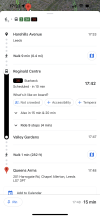There is no reason not to do this, and is still the norm in several countries that no longer have printed timetables. Bus stop timetables don't suffer from one of the major difficulties with printed timetables, the problem with timetables being out of date. Although there's a debate whether departure times on their own are sufficient, or whether you should have full timetables. The consensus, especially in urban areas, seems to be departure times only, with maybe some indication of journey time as well. When you have such indication, main stops, rather than every stop, is the norm, although all stops may be possible in urban areas.
In this respect, TfL is probably doing better than the old days, although recent budget cuts sometimes mean that bus stops don't get updated when they should. In the 80s many London bus stops didn't have the service numbers on the flag, now you have the service numbers, name of stop and direction. Actual timetables are vague, generally just showing first and last buses with the frequency, but as mentioned earlier, most London buses are supposed to be spaced evenly rather than sticking to a timetable. In the old days you would get a proper timetable at the bus stop, but they were more necessary due to lower frequency.
In Hong Kong, the information printed at bus stop includes:
- the full route, including
every stop along the route (there were some all-stop routes with paper omitted some rural stops in a row, for example, 3 consecutive stops in a village shown as 1 stop, but complaints were launched and now every stop is shown as in urban routes)
- the fare applicable
- the departure times or headway from origin station
- in the past, interchange discounts as well, but as the amount exploded it is now omitted on some routes with only a summary given
with one piece of paper per route (in some circumstances, a group of related routes), nicknamed "rooster paper" because the plate where the paper is placed in looks like a rooster plate. The plate is usually in triangular form fixed around the pole which is rotatable.
A gallery how they look like can be found at this article. These are also available to be downloaded as PDFs for some bus companies.
However, compared to Western norm, they don't have the times for individual stops as buses in Hong Kong (only the departure time or headway from the origin station is shown), apart for a few rural routes or circular routes, don't have any timing points except the origin, and the sheer amount of buses in the urban area also make it impractical to have any timing points en-route as dedicated stop space is required to do so, as such bus bunching is very common on a long route or on a route running through congested urban areas.
The information is always kept updated except a fare scale change, when a notice is stuck to show the new fare temporarily until the papers are gradually replaced. The way of updating is simple, just go through the route from the beginning to the end, take down the old one and stuck the new one on, which is done as part of the general bus stop maintenance.

